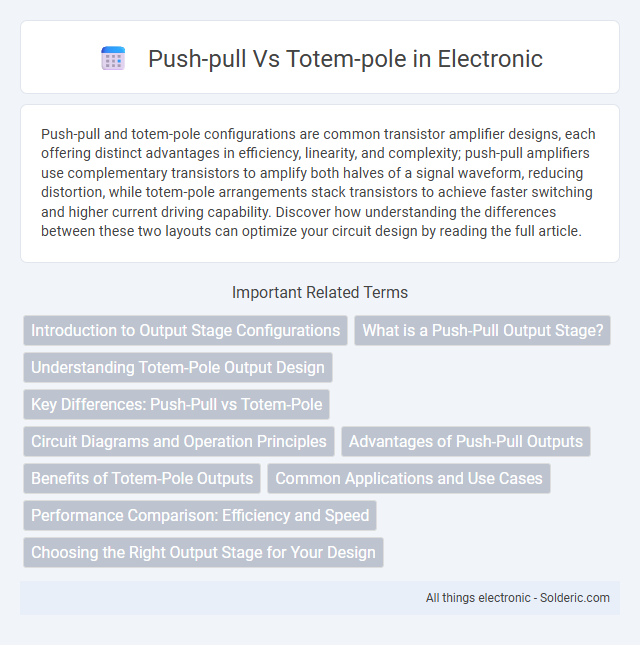Push-pull and totem-pole configurations are common transistor amplifier designs, each offering distinct advantages in efficiency, linearity, and complexity; push-pull amplifiers use complementary transistors to amplify both halves of a signal waveform, reducing distortion, while totem-pole arrangements stack transistors to achieve faster switching and higher current driving capability. Discover how understanding the differences between these two layouts can optimize your circuit design by reading the full article.
Comparison Table
| Feature | Push-Pull | Totem-Pole |
|---|---|---|
| Definition | Output stage using complementary transistors alternately to push and pull current. | Active output stage with transistors stacked vertically (one on top of another). |
| Configuration | Parallel complementary transistors for sourcing and sinking current. | Series-connected transistors; one transistor sources current, other sinks. |
| Switching Speed | Moderate switching speed. | High switching speed due to reduced charge storage. |
| Output Drive Capability | Good for driving resistive loads. | Better current drive for both sourcing and sinking. |
| Complexity | Simple design, easy to implement. | More complex design with stacked transistors. |
| Applications | Audio amplifiers, basic driver circuits. | Switching power supplies, high-speed digital outputs. |
| Efficiency | Lower efficiency due to crossover distortion. | Higher efficiency, reduced distortion. |
Introduction to Output Stage Configurations
Push-pull and totem-pole output stages are fundamental configurations in amplifier design, each offering distinct benefits for efficient signal amplification. Push-pull stages use complementary transistors to drive the load alternately, reducing distortion and improving power efficiency. Totem-pole configurations stack transistors vertically, enabling higher output voltage swings and faster switching speeds, making them suitable for high-frequency applications.
What is a Push-Pull Output Stage?
A push-pull output stage uses two transistors or tubes working in tandem to amplify both halves of an audio signal, enhancing efficiency and reducing distortion. In this configuration, one device pushes current to the load during the positive half-cycle, while the other pulls current during the negative half-cycle. Understanding this arrangement is vital for optimizing your amplifier's performance compared to totem-pole configurations, which use a different transistor setup to achieve similar goals.
Understanding Totem-Pole Output Design
Totem-pole output design utilizes a pair of transistors arranged in series to provide both sourcing and sinking current capabilities, enabling efficient switching and low output impedance. Unlike push-pull configurations that have complementary devices driving the load, totem-pole outputs stack NPN and PNP transistors to rapidly drive the output high or low while minimizing power dissipation. Understanding this design helps you optimize signal integrity and switching speed in digital and analog circuits.
Key Differences: Push-Pull vs Totem-Pole
Push-pull amplifiers use complementary transistors to alternately drive the load during positive and negative signal cycles, minimizing distortion by reducing crossover distortion. Totem-pole configurations stack transistors vertically to provide better current drive and faster switching speeds in digital circuits, commonly found in push-pull output stages of logic gates. Understanding these key structural and operational differences can help you choose the right topology for your amplifier or switching application.
Circuit Diagrams and Operation Principles
Push-pull circuits use two transistors alternately to drive current through the load, with one transistor sourcing current during the positive half-cycle and the other sinking current during the negative half-cycle, as depicted in their characteristic circuit diagrams featuring complementary active devices. Totem-pole configurations stack transistors vertically, enabling a push-pull-like operation within a single output stage by sourcing and sinking current more efficiently, often shown in diagrams with series-connected transistors sharing the same output node. Understanding these operation principles helps maximize your circuit performance by selecting the appropriate topology based on switching speed, power efficiency, and load characteristics.
Advantages of Push-Pull Outputs
Push-pull outputs provide high efficiency and fast switching speeds by actively driving the output both high and low, reducing power loss compared to totem-pole configurations. They offer improved linearity and better thermal management, making them ideal for audio amplifiers and RF applications. Your choice of push-pull designs ensures lower distortion and enhanced output power handling.
Benefits of Totem-Pole Outputs
Totem-pole outputs provide faster switching speeds and lower output impedance compared to push-pull configurations, enhancing signal integrity and reducing distortion in digital circuits. They enable higher current driving capability, which improves the performance of high-frequency applications and driving capacitive loads effectively. The compact design of totem-pole outputs also optimizes power consumption, offering efficient energy usage in integrated circuit implementations.
Common Applications and Use Cases
Push-pull amplifiers are commonly used in audio amplification and radio frequency transmitters due to their efficiency in reducing distortion and improving output power. Totem-pole configurations are prevalent in digital logic circuits and power supply designs, offering fast switching speeds and efficient current drive capabilities. Both topologies are essential in power electronics, with push-pull suited for linear amplification and totem-pole ideal for switching applications.
Performance Comparison: Efficiency and Speed
Push-pull and totem-pole configurations differ significantly in performance, with totem-pole designs offering higher efficiency and faster switching speeds due to their complementary transistor arrangement reducing power loss. Push-pull circuits may exhibit slower response times and increased distortion, impacting overall speed and signal fidelity in high-frequency applications. Optimizing your power electronics often involves choosing totem-pole drivers for enhanced efficiency and rapid switching demands.
Choosing the Right Output Stage for Your Design
Selecting the right output stage hinges on balancing efficiency, linearity, and complexity; push-pull configurations excel in delivering high power with reduced distortion, ideal for audio amplifiers requiring robust performance. Totem-pole stages offer faster switching speeds and lower voltage drops, making them suitable for digital circuits where switching efficiency and compact design matter. Evaluating load requirements, signal fidelity, and power consumption ensures optimal integration of either push-pull or totem-pole topologies in your electronic design.
Push-pull vs Totem-pole Infographic

 solderic.com
solderic.com